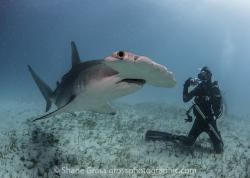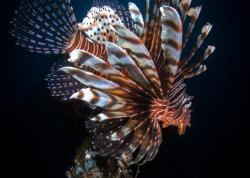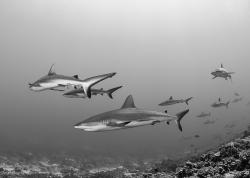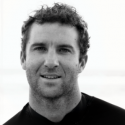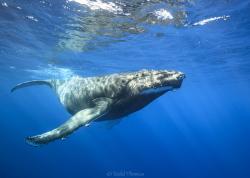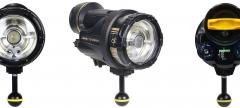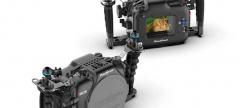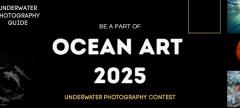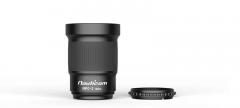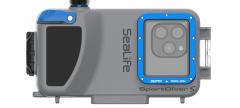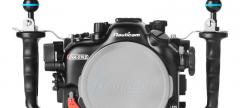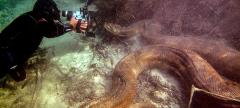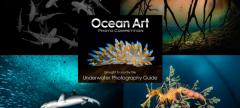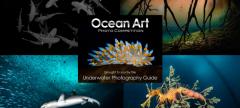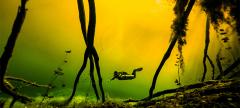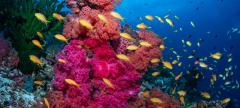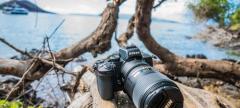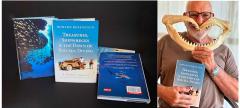Diving with Anacondas in Bonito, Brazil
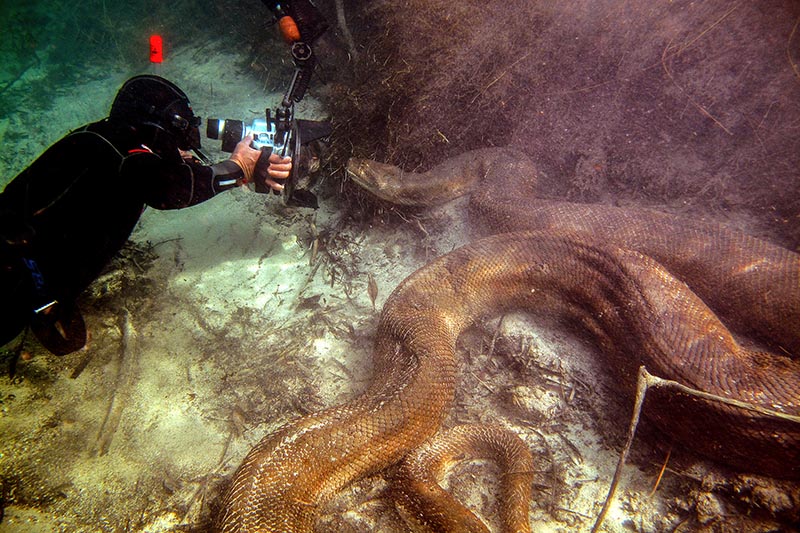
Why it’s special
 Of the four species of anaconda that exist, three can be found in Brazil. The largest of these is the green anaconda, the world’s heaviest snake, which can grow up to 250kg. While sliding into the water with one of these serpents may not be every diver’s dream, it’s certainly a unique experience and, with a knowledgeable guide, less risky than you might think. The waterways surrounding the remote town of Bonito in Brazil is where all the action takes place, with the rivers becoming clear enough during the dry season to jump in and spot these river monsters underwater.
Of the four species of anaconda that exist, three can be found in Brazil. The largest of these is the green anaconda, the world’s heaviest snake, which can grow up to 250kg. While sliding into the water with one of these serpents may not be every diver’s dream, it’s certainly a unique experience and, with a knowledgeable guide, less risky than you might think. The waterways surrounding the remote town of Bonito in Brazil is where all the action takes place, with the rivers becoming clear enough during the dry season to jump in and spot these river monsters underwater.
Photography Tip
Obviously, an anaconda is huge so you’ll want to shoot relatively wide. With that said, it’s difficult to guess how much of the anaconda will be visible in advance, so I recommend a wide lens that has a good zoom on it. This allows for the possibility of a nice portrait close up. Something like a 16-35mm.
Dive In
The Pantanal in Southwest Brazil is the world’s largest tropical wetland area, and a wildlife watcher’s dream. Blue macaws, giant anteaters, jaguars, and capuchin monkeys are just a few of the animals you can see here. Though the Amazon is more well-known, the open, savannah landscape of the Pantanal make for better wildlife viewing. Each wet season (December to March), the Pantanal turns into a giant floodplain as torrential rains bucket down on the thirsty countryside and then, by the time mid-year rolls around, the swollen rivers have reduced in size, lagoons have shrunk, and fields are dry enough for animals to graze again. In the absence of dirty run-off, water visibility is at its best for spotting marine life. During this time, you can come face-to-face in the water with the world’s heaviest snake, the green anaconda. Yep, you read that correctly.
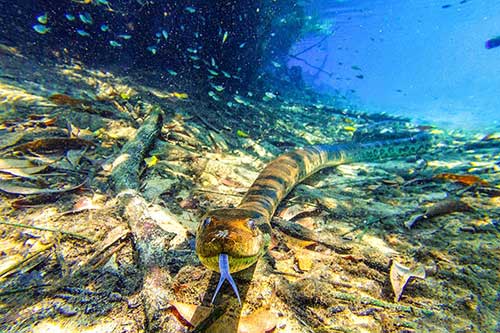 The remote town of Bonito is the gateway to the action, a four hour drive from the Campo Grande airport. The waterways near Bonito, which interconnect with the Pantanal wetlands, are where you can reliably find green anacondas. Not only can you see them but, with the help of an experienced guide, you can dive with them the only place on the planet where you can do so. In other places they habit, the water is simply too murky to see them. Native to South America, giant anaconda, or ‘sucuri’ as they are called in Brazil, can measure up to nine metres long and weigh up to a whopping 250kg. Being semiaquatic, they prefer to hang out in swamps, marshes and streams, where they’re much more agile than they are on land, and therefore more efficient hunting prey.
The remote town of Bonito is the gateway to the action, a four hour drive from the Campo Grande airport. The waterways near Bonito, which interconnect with the Pantanal wetlands, are where you can reliably find green anacondas. Not only can you see them but, with the help of an experienced guide, you can dive with them the only place on the planet where you can do so. In other places they habit, the water is simply too murky to see them. Native to South America, giant anaconda, or ‘sucuri’ as they are called in Brazil, can measure up to nine metres long and weigh up to a whopping 250kg. Being semiaquatic, they prefer to hang out in swamps, marshes and streams, where they’re much more agile than they are on land, and therefore more efficient hunting prey.
Patience and a great local guide are necessary for this mission, as anacondas’ excellent camouflage makes them hard to spot and they’re usually quick to disappear after sensing you. Once underwater, they can spend up to ten minutes below before resurfacing for another breath. Since they’re easily spooked by noise, your boat ride through the wetlands will involve motoring quietly and speaking in whispers. Ideally, you’ll spot one on the riverbank sunning itself, and then when it slides into the water, you’ll quickly follow it in. In the shallow depth of between one to four metres, you can SCUBA or snorkel, usually with several metres of visibility. Topside, there’s plenty to see while you’re motoring along, like caimans and river otters, though ultimately you need to prepare for long, tiring days under the sun.
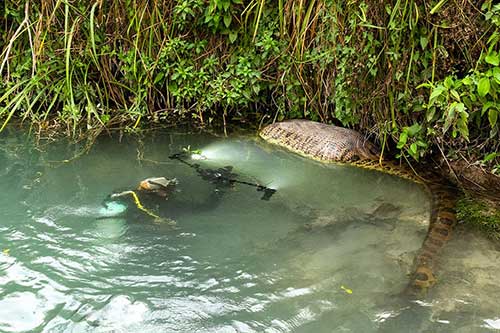 These trips are highly specialised, as they were originally only organised for film crews, but they’ve now hit the radar of underwater photographers. In the process of writing Ultimate Dive Sites, I spent a year and a half researching and reaching out to the few operators that advertise this experience, eventually getting hold of a bilingual guide and biology graduate named Marcos Violante. Marcos, who has worked as a naturalist guide in the Pantanal since 1996, is at the forefront of Bonito’s anaconda scene, offering trips for small groups (maximum five) between July and September. Marcos’ tour packages are seven days, with five of those days being out on the field. The aim is to find a big, female anaconda which Marcos says is by no means guaranteed, though there’s a very good chance you’ll find an anaconda, even if it’s a smaller male. They are long days from 8.30am until sunset, with the best time to spot anacondas being between 11am and 4pm.
These trips are highly specialised, as they were originally only organised for film crews, but they’ve now hit the radar of underwater photographers. In the process of writing Ultimate Dive Sites, I spent a year and a half researching and reaching out to the few operators that advertise this experience, eventually getting hold of a bilingual guide and biology graduate named Marcos Violante. Marcos, who has worked as a naturalist guide in the Pantanal since 1996, is at the forefront of Bonito’s anaconda scene, offering trips for small groups (maximum five) between July and September. Marcos’ tour packages are seven days, with five of those days being out on the field. The aim is to find a big, female anaconda which Marcos says is by no means guaranteed, though there’s a very good chance you’ll find an anaconda, even if it’s a smaller male. They are long days from 8.30am until sunset, with the best time to spot anacondas being between 11am and 4pm.
At around USD $10,000 per person (for two people travelling together), the price reflects the exclusive nature of the trip. For a group of four, the price drops to around USD $7,000 per person. You can connect with Marcos via his email mviolante99@gmail.com. Daniel de Granville also offers wildlife expeditions via his company Photo In Natura (photoinnatura.com).
**This is an edited extract from Ultimate Dive Sites by Todd Thimios, published by Hardie Grant Explore – out on 1 February 2025. Dive guide, photographer and author Todd Thimios has completed more than 3500 dives and within this book he’s curated a collection of 50 of the world’s ultimate diving experiences.
RECOMMENDED ARTICLES
SUPPORT THE UNDERWATER PHOTOGRAPHY GUIDE:
The Best Service & Prices on u/w Photo Gear
 Visit Bluewater Photo & Video for all your underwater photography and video gear. Click, or call the team at (310) 633-5052 for expert advice!
Visit Bluewater Photo & Video for all your underwater photography and video gear. Click, or call the team at (310) 633-5052 for expert advice!
The Best Pricing, Service & Expert Advice to Book your Dive Trips
 Bluewater Travel is your full-service scuba travel agency. Let our expert advisers plan and book your next dive vacation. Run by divers, for divers.
Bluewater Travel is your full-service scuba travel agency. Let our expert advisers plan and book your next dive vacation. Run by divers, for divers.




